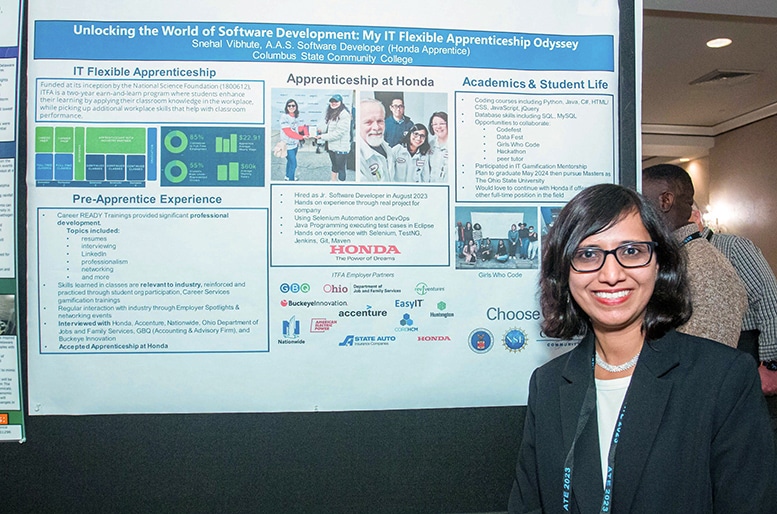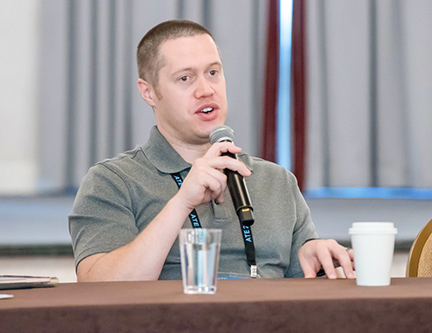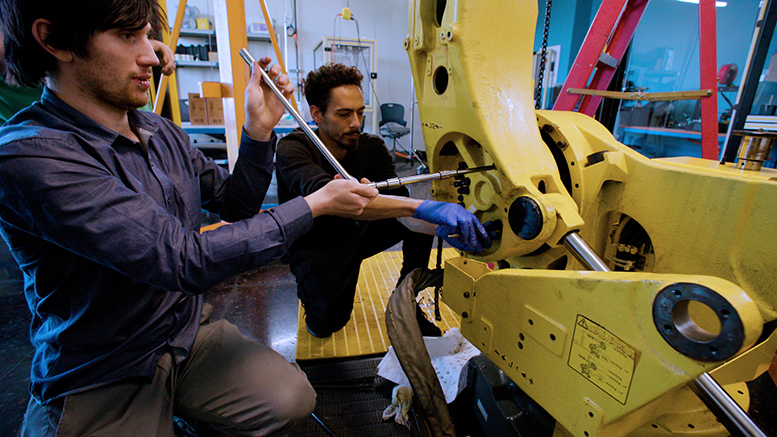Apprenticeships are among the five types of work-based learning experiences that Advanced Technological Education projects and centers offer.
They are the favorites of Snehal Vibhute, a student at Columbus State Community College (Ohio), and James Peyton Lucas, who attends a community college in North Carolina. Both presented information about their apprenticeships during the student poster session at the 2023 ATE Principal Investigators’ Conference in October. The American Association of Community Colleges hosts the conference with support from its Advanced Technological Education grant from the National Science Foundation.
Lucas had an unpaid internship in 2022-2023, his first year in college — having matriculated directly from his rural high school.
“By doing this apprenticeship, I found out I like web design,” he said of his September 2023 placement with Communities in School, a nonprofit. He had previously planned to go into networking.
“It gave me my first opportunity at a real job. I used to work odd jobs and stuff,” he said. Asked if he would have taken the 20-hour per week job experience if it did not pay $15 per hour, Lucas conceded, “Possibly, but I prefer getting paid.”
Lucas was one of nine interns placed last year by Cyber Connect, an ATE project. His apprenticeship is underwritten by a North Carolina information technology (IT) program.
ESL and more
Vibhute, too, is excited about learning new software tools and earning money. She is paid $20 per hour as a junior software developer at Honda, which has a large auto manufacturing facility in central Ohio.

The pay eases the challenge of leaving her house about 6 a.m. on weekdays to work 40 hours each week, take evening classes on campus two evenings a week, and juggle care of her two children with her husband. Asked if her apprenticeship would last until she receives her associate degree in May, Vibhute replied, “Yes, it’s just awesome! Don’t you think?”
Vibhute enrolled at Columbus State for English-as-a-second-language classes in January 2022 through Ohio’s Aspire program. The free program provides services to help adults succeed in postsecondary education. Vibhute earned a bachelor’s degree in India, where she worked as a math teacher prior to immigrating to the US in 2019 with her husband, a research scientist at Ohio State University, and their two children who are now five and nine years old.
When her English language skills improved, an instructor selected her to be a peer tutor for the English composition course. Last fall, she enrolled in the Information Systems Technology Department’s IT Flexible Apprenticeship (ITFA) program, which is supported by an ATE grant and a U.S. Department of Labor (DOL) grant. In addition to taking foundational IT courses, Vibhute said, ITFA guides students in writing resumes, prepping for job interviews, and preparing to work in advanced technology workplaces.
Vibhute said the experiences she’s had during her first two months as an apprentice at Honda have affirmed her decision to shift to an IT career.
Diverse student populations
Geoff Bauer, ITFA program manager, shared data and reported other positive results during the Earn and Learn session at the ATE PI Conference.

“We’re really developing a brand over time,” he said, of the companies that have sought apprentices after hearing about the program from other employers.
Since ITFA started in 2017, it has placed 20 to 30 students each year in apprenticeships. Eighty percent of the apprentices have been offered jobs by the companies where they apprenticed. And Bauer pointed out those not offered work gained a year of on-the-job experience that many IT employers require for entry-level positions.
“The worst-case scenario is not that bad,” he said.
Most of the ITFA apprentices are from racial and ethnic populations historically underrepresented in STEM fields. Women are 33% of the 2022-2023 cohort now working as apprentices; nationally women are 27% of the IT workforce, Bauer said.
Bauer said personnel from Accenture have told him they like hiring from Columbus State’s IT graduates because they are looking for people with creative problem-solving skills.
“They are taking advantage of the fact that you have people from differing perspectives,” he said.
Alignment with industry credentials
Montcalm Community College offers both registered apprenticeships and non-registered apprenticeships, depending on what the employers want for the technicians they are paying to participate in the college’s apprenticeship programs.
“I can 100% say that without our apprentices we would not have a technical area,” said Deborah Dawson-Gunter, faculty for the automation and advanced industrial Technology program at the Michigan college.
Dawson-Gunter was the principal investigator of the Educating Robot Technicians ATE project that designed 10 new courses for the automation maintenance associate degree and certificate to align with industry credentials that employers recognize and reward.
“We have very strong partnerships with our local companies. They are sending their employees to us for additional training,” she said during the conference panel.
In the midst of the Covid pandemic, the project developed simulators for remote instruction of electrical circuits, control diagrams, and motor controls that students still use to practice skills before doing in-person lab exercises. The college’s lab is open from 7 a.m. to 10 p.m. to accommodate students’ work schedules.
Dawson-Gunther’s attentive approach also means employers receive weekly performance reports about their apprentices. She said this “leads to students being very serious about learning.” Students who complete apprenticeship courses are generally rewarded with higher pay, she said.
Practicum sites across the country
The Viticulture and Enology Science and Technology Alliance (VESTA), an ATE Center based at Missouri State University, partners with community college educators throughout the United States to offer industry-validated online courses and field experiences in viticulture, enology and entrepreneurship.
Since 2003 VESTA has developed a network of more than 700 commercial winery facilities that have served as practicum sites for hands-on learning. The average age of VESTA students has ranged from 40 to 44. Most VESTA students are looking for a second area of employment or to diversify their farming operations, said Michelle Brewer, director and principal investigator of VESTA.
She explained at the conference panel that the degrees and certificates VESTA has developed over the years respond to students and industry partners’ desires for workplace learning and technical instruction.
In recent years, VESTA has worked with industry associations, their employer members and employees to support DOL-registered apprenticeships with comprehensive apprenticeship outlines that incorporate VESTA courses as the related technical instruction required for apprenticeship completion.
“It’s another arrow in our quiver,” she said.

